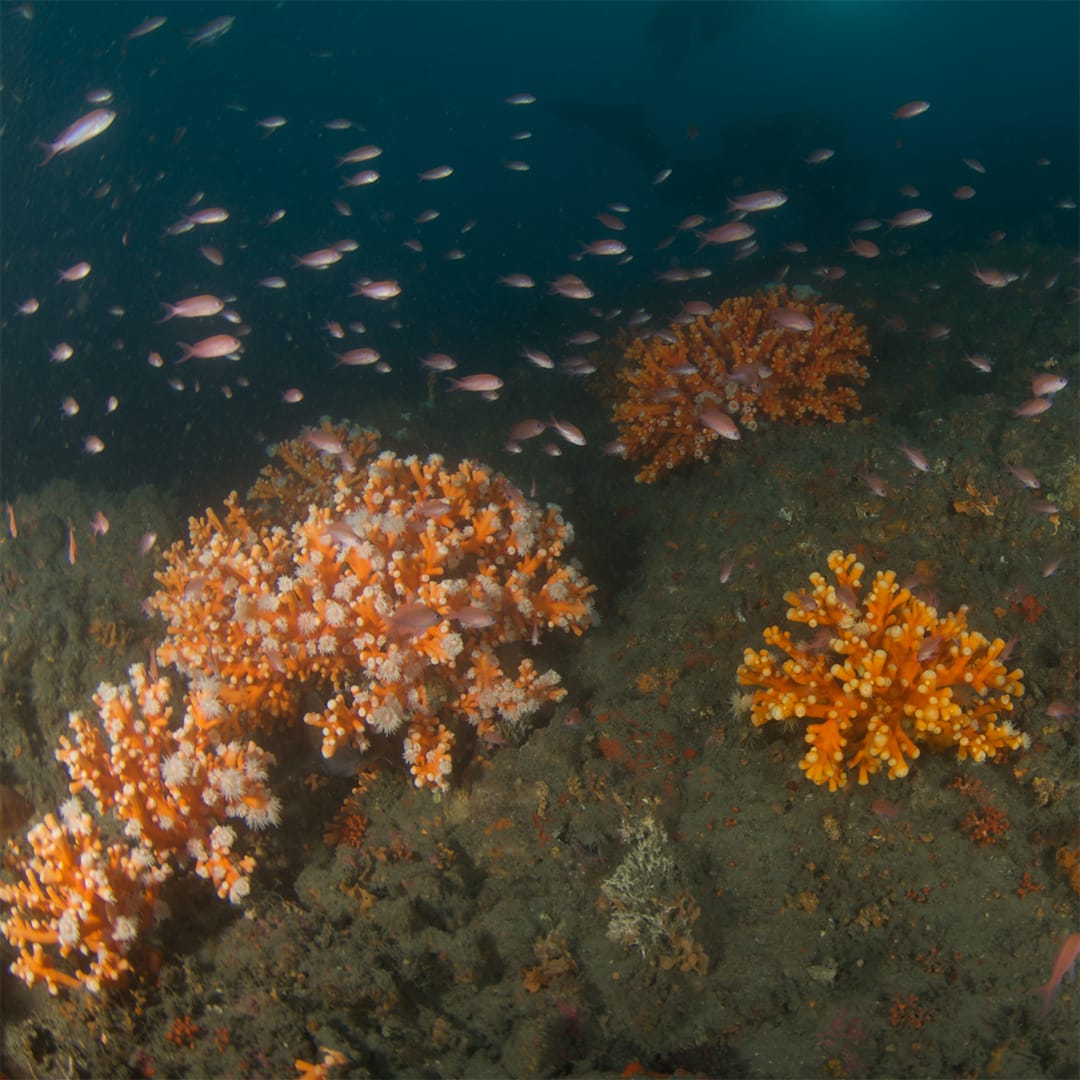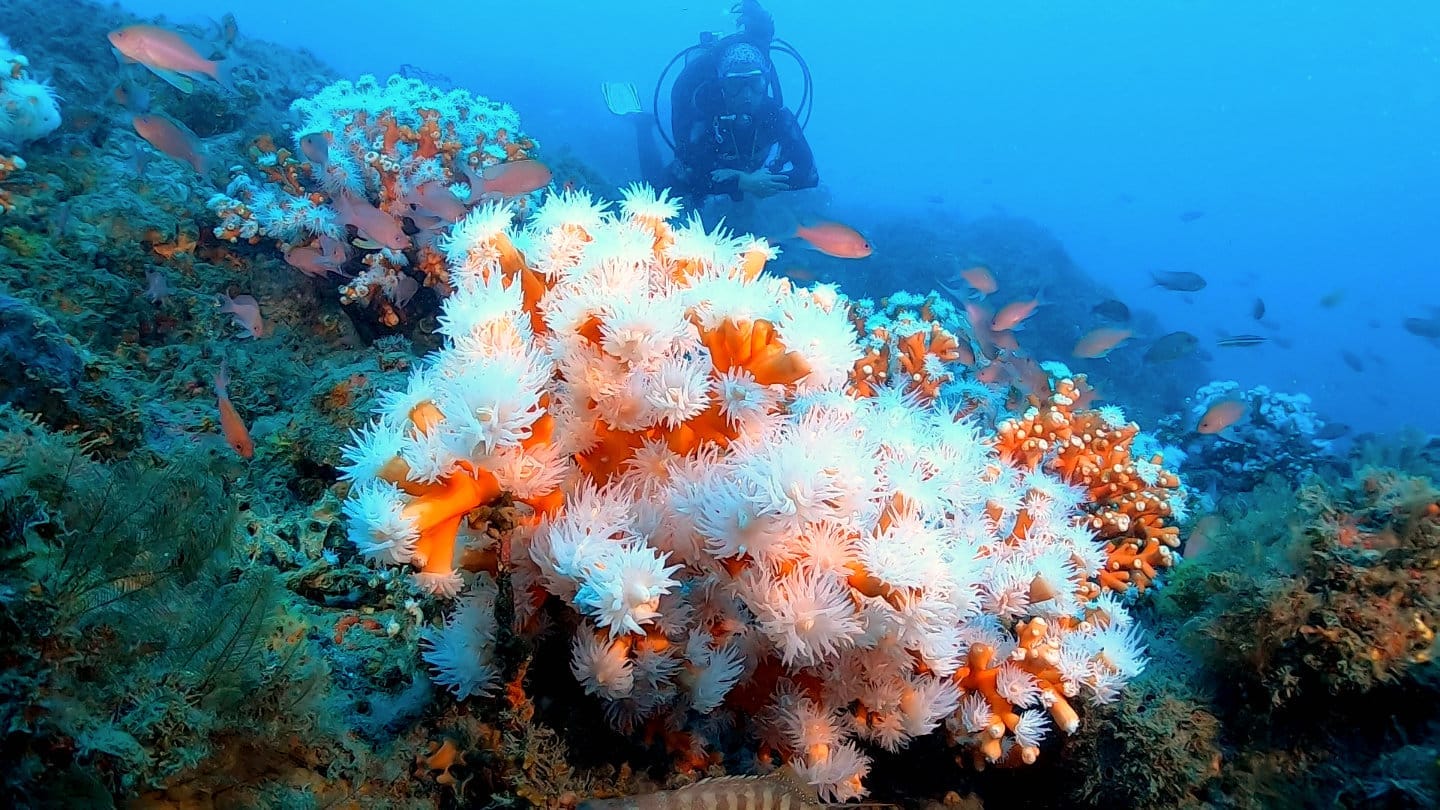Cold-water coral biodiversity: the case of coral mounds in the Alboran Sea

The first biological descriptions of cold-water coral bottoms took place in the mid-19th century [1]. At that time, tropical coral reefs were already well known to scientists, unlike their deep-water siblings. Over the years, some studies have shown the existence of deep-water coral mounds, created by the accumulation of limestone skeletons of corals that have established in areas with favorable conditions. These deposits form reefs that offer food, habitat and other resources needed for the development of deep-water species. However, studies on coral mounds are often conducted on a local scale, leaving aside the regional vision. This was the case of the Alboran Sea.
The Alboran Sea and the corals of Cabliers
The Alboran Sea is the westernmost part of the Mediterranean Sea between southern Spain and northern Morocco (Fig 1). In this region, oceanographic conditions are regulated by exchanges between the Mediterranean Sea and the Atlantic Ocean. The particularity of this sea lies in the morphology of the seabed resulting from tectonic activity. Indeed, plates’ subduction constitute a habitat rich in hard substrates which favor corals’ establishment.
Here, the coral mounds from the province of Cabliers extend along 25 km and reach up to 140 m high, with a minimum depth of 200 m (Fig 1) [2]. Given the abundant coral cover in the area, these mounds caught the attention of a team of scientists from different institutions coordinated by researcher Guillen Corbera, interested in studying the coral distribution and associated biological community [2].

Figure 1. Location of the Alboran Sea and the mound of corals from the province of Cabliers (black rectangle). Source: modified from [2].
Distribution of corals on mounds
With videos and photos gathered by Remotely Operated Vehicles (ROV), scientists studied the seabed communities of the Cabliers’ mounds. They found that corals are not distributed evenly on mounds, but abundance varies depending on the location and on certain conditions.
At the top of the mounds, known as crests, colonies of hard corals are abundant, while on the flanks of the mounds almost no coral of this kind is visible. This abundance at the crests is consistent with the presence of “mini-mounds” at the top of the mounds, as the authors have called them (Fig 1).These structures are important for cold-water corals because they expose them to strong currents, which prevents sediment accumulation and constitutes a constant food supply, unlike the lower areas of the mounds (Fig 2).
Associated biological communities
Linked to the oceanographic conditions, the assemblage of coral species’ on the Cabliers’ mounds varies depending on the area. In the northern area, mounds are exposed to strong currents, which benefits coral establishment. Here, the coral community is dominated by two main species: Lophelia pertusa and Madrepora oculata, which are more abundant and larger in the crest areas. Whereas, in the southern areas, the mounds are mainly structured around dead corals and fine sediments, suggesting a less suitable habitat for building corals (Fig 2). The main species encountered here are “soft corals”, in particular the gorgonian Acanthogorgia hirsuta and the black coral Parantipathes larix.
According to the scientists’ analysis, the differences between the coral communities of the northern and southern zones are due partly to environmental conditions. However, they represent two ecological moments of the coral mounds. In the north, greater hard coral cover and diversity represents a thriving coral community. While in the south, soft coral dominance, sediments, and low abundance of building organisms are closer to a cold-water coral community in decline. However, further studies are needed to test the validity of this interpretation.
When compared to the coral communities in other mounds in the Mediterranean Sea or Atlantic Ocean, there are differences in Cabliers’ mounds in terms of species and their abundance [2]. It shows that the composition of the fauna seems to be determined by both oceanographic and biogeographic factors. Amongst these factors are water temperature, dissolved oxygen concentration, and larval dispersal which depends on currents and substrate [2].

Figure 2. Schematic representation of bottom species on the mini-crests of the northern (A) and southern (B) mounds. Source: [2].
Regarding the fish community, most of the reported species are the same found in other coral mounds of the Mediterranean, some of which are commercially important. In particular, juveniles and adults of the sebastidae species (Helicolenus dactylopterus) have been found, confirming the importance of these ecosystems for local fish populations and associated fisheries. However, no traces of dredge fishing were reported in the area.

Figure 3. Dominant fish species in Cabliers’ mounds: Helicolenus dactylopterus (Source: NOAA Okeanos Explorer Program).
This research provides an ecological description of the Cabliers’ coral mounds in the Alboran Sea, from which just a part of the results is presented here. Findings show that the coral density and abundance is greater at the tops of the mounds compared to the flanks, especially in the northern area. These findings show the heterogeneity of coral cover linked to both environmental and biogeographical factors. They also provide a glimpse of the importance of these ecosystems to fisheries. However, more investigations are needed to further understand the assemblage of deep coral bottoms and predict responses of the biological community to environmental changes.
📸 : Javier Sánchez
References:
[1] Orejas C, Jiménez C (2019). Mediterranean Cold-Water Corals: Past, Present and Future Understanding the Deep-Sea Realms of Coral. Coral Reefs of the World Volume 9. Springer Nature Switzerland AG. 582 pp.
[2] Guillem Corbera, Claudio Lo Iacono, Eulàlia Gràcia, Jordi Grinyó, Martina Pierdomenico, Veerle A.I. Huvenne, Ricardo Aguilar, Josep Maria Gili, Ecological characterisation of a Mediterranean cold-water coral reef: Cabliers Coral Mound Province (Alboran Sea, western Mediterranean), Progress in Oceanography, Volume 175, 2019, Pages 245-262.


